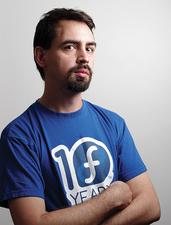The old hat that's still new
Distro Walk – Fedora

Matthew Miller, Fedora Project Leader, discusses Fedora's relationship with Red Hat and its role in the Linux community.
The Fedora Project [1] was started in 2003 as the community face of the newly established Red Hat Enterprise Linux (RHEL). Although sometimes dismissed as no more than a beta release for RHEL, Fedora quickly became a popular community choice as well, with numerous spins and builds. Twenty years later, it is also one of the main sources for numerous major commercial distributions, including RHEL, CentOS Stream, Rocky Linux, and AlmaLinux, as well as a dozen derivatives in its own right.
Matthew Miller has been Fedora Project Leader since 2014. As he prepared for Flock, the Fedora Project's annual conference, in Cork, Ireland, in August 2023, Miller kindly agreed to talk about the current state of Fedora.
Linux Magazine (LM): Tell us about your involvement in free software.
[...]
Buy this article as PDF
(incl. VAT)
Buy Linux Magazine
Subscribe to our Linux Newsletters
Find Linux and Open Source Jobs
Subscribe to our ADMIN Newsletters
Support Our Work
Linux Magazine content is made possible with support from readers like you. Please consider contributing when you’ve found an article to be beneficial.

News
-
Debian Unleashes Debian Libre Live
Debian Libre Live keeps your machine free of proprietary software.
-
Valve Announces Pending Release of Steam Machine
Shout it to the heavens: Steam Machine, powered by Linux, is set to arrive in 2026.
-
Happy Birthday, ADMIN Magazine!
ADMIN is celebrating its 15th anniversary with issue #90.
-
Another Linux Malware Discovered
Russian hackers use Hyper-V to hide malware within Linux virtual machines.
-
TUXEDO Computers Announces a New InfinityBook
TUXEDO Computers is at it again with a new InfinityBook that will meet your professional and gaming needs.
-
SUSE Dives into the Agentic AI Pool
SUSE becomes the first open source company to adopt agentic AI with SUSE Enterprise Linux 16.
-
Linux Now Runs Most Windows Games
The latest data shows that nearly 90 percent of Windows games can be played on Linux.
-
Fedora 43 Has Finally Landed
The Fedora Linux developers have announced their latest release, Fedora 43.
-
KDE Unleashes Plasma 6.5
The Plasma 6.5 desktop environment is now available with new features, improvements, and the usual bug fixes.
-
Xubuntu Site Possibly Hacked
It appears that the Xubuntu site was hacked and briefly served up a malicious ZIP file from its download page.

